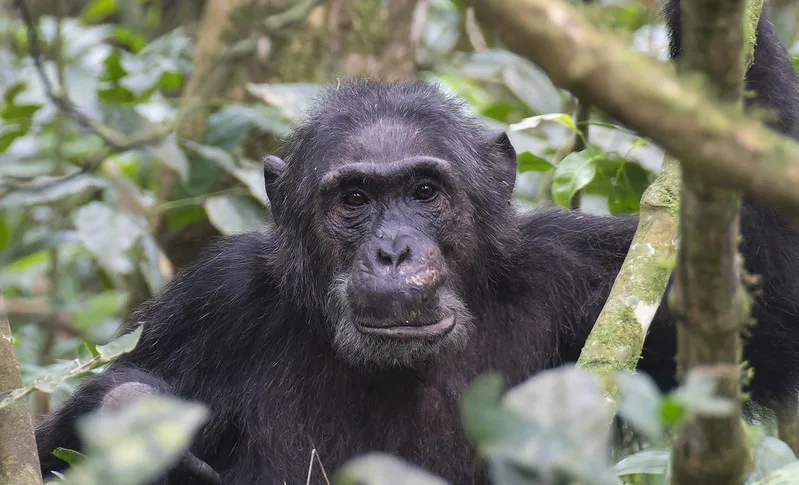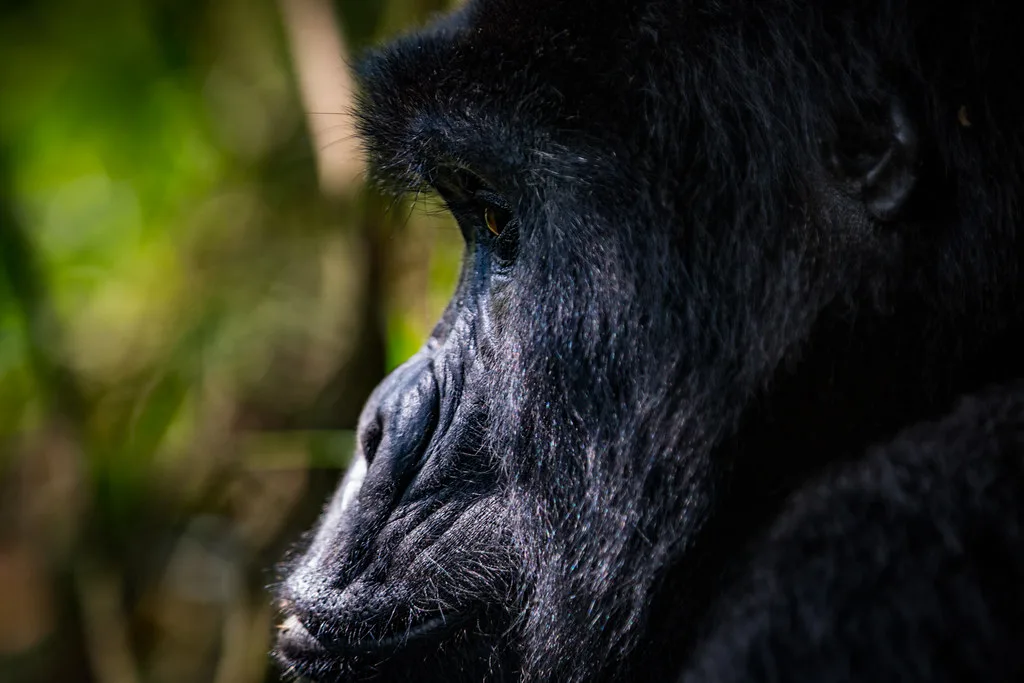Frequently asked questions about chimpanzee trekking in Uganda and Rwanda.
Chimpanzee trekking Trips in Uganda. Trekking among habituated wild chimpanzees is the pastime of following them. With around 98% human DNA, chimps are the closest cousins of man. Under the direction of an Alpha male democratically chosen by the members, they live in communities. Women greatly determine who is chosen as alpha male; hence, applicants have to make an impact on them to be appointed into leadership.
Where in Uganda and Rwanda may one discover chimps?
Kibale National Park | Chimpanzee trekking Trips in Uganda
East Africa’s most habituated chimpanzees live in this tropical jungle in Uganda. Right now, Kibale National Park has 1500 chimpanzee residents. About 795 square kilometers of this forest house 13 primate species. Among these primate species are chimpanzees, black and white colobus, grey-cheeked mangabey, vervet monkeys, blue monkeys, olive baboons, red-tailed monkeys, and so on.
Two tourist centers of Kibale National Park include Sebitoli secondary center and Kanyanchu visitor center.
Its northern part maintains the rich forest cover as it is the wettest and gets an average of roughly 1800 mm of rain yearly. Kibale National Park’s Southern section has a wide savanna and a drier climate. Kibale adjoins Queen Elizabeth National Park, divided by a large migratory corridor of 180 kilometers that promotes wildlife to travel from Queen Elizabeth National Park into Kibale National Park periodically in the southern sector.
Especially when you visit the Bigodi Wetland, Kibale National Park is a fantastic place for birdwatching. Standing at the observation platform, you may be able to see birds such as Black and white Mannikin, Green-backed Twin Spot, shoebill, rare Grey-headed olive-back, and others.
To be allowed to attend either of the two morning or afternoon sessions, you must reserve a chimpanzee trekking permit from Uganda’s Wildlife Authority.
Kyambura Gorge within Queen Elizabeth National Park | Chimpanzee trekking Trips in Uganda
River Kyambura, which empties into the Kazinga channel, sculpts Kyambura Gorge right at the bottom of the rift valley. Booking a chimpanzee hiking permit from Uganda Wildlife Authority will allow you to reach this wooded spot in Queen Elizabeth National Park.
You have to have chimpanzee hiking equipment, as they reside on hills you may have to climb to find the chimps. The slick slopes during the wet seasons make the climb in Kyambura Canyon somewhat difficult. Normally, Queen Elizabeth National Park’s rainy season runs from March to May or November; all other elements remain consistent.
Kaniyo Pabidi inside Murchison Falls National Park | Chimpanzee trekking Trips in Uganda
Although part of Murchison Falls National Park, this wooded area is Budongo woodland. There are some of the last growing Mahogany trees in Uganda, filling Kaniyo Pabidi. Black and white colobus, vervet monkeys, grey-cheeked mangabey, red-tailed monkeys, blue monkeys, and others call Kaniyo Pabid home among chimpanzees, diverse primates.
Furthermore, a fantastic place for birds is Murchison Falls National Park. You could be lucky to find birds such as Silverbird, Black-headed Gonolek, chestnut crowned Sparrow weaver, Green-winged Pytilia, and more.
Ngamba Chimpanzee Sanctuary
Chimpanzees abandoned and unable to return to their society, orphaned, or rescued from snares, and others find a refuge here. Although many crimes occur against the chimpanzees, this center exists to educate the nearby residents and guests on the value of chimpanzee habitat and preservation.
You may schedule to sail to Koome Island, where this facility is located, and show up for either of the wo morning or afternoon sessions. Arriving at feeding time, you could stand at the guest platform to help feed the chimps. See how every chimpanzee fights to get food during the day.
The Nyungwe National Park
Chimpanzees call Nyungwe National Park home in Rwanda. Its headquarters are located in Uwinka. Other chimpanzees in Rwanda may be seen in Cyamudondo, outside of Nyungwe National Park. Various paths bring you into the jungle to share that one permitted hour with these chimps.
Though really fascinating to watch, the Rwanda chimpanzees are semi-habituated. Other primates include blue monkeys, olive baboons, grey-cheeked mangabey, blue monkeys black and white colobus may also be seen here.
When should one book chimpanzee Trekking permits in Uganda and Rwanda?
Trekking in Uganda and Rwanda among chimpanzees is an all-year-round activity. Since only six chimpanzees in each group, you must book your permission for trekking ahead. There are two daily sessions for chimpanzee trekking, morning and afternoon ones.
In Uganda, you need to know where you want to undertake chimpanzee trekking, or contact our expert so that a fantastic itinerary can be customized for you and help you to avoid zigzag travel. Time is required for this. Only Nyungwe National Park hosts Rwanda chimpanzee trekking.
Most people would rather schedule their chimpanzee trekking permits for June through September and December through January. Normally, they are supposed to be dry months. Chimpanzees eat closer to the earth, and the forest suffers from less humid conditions. Even some other woodland residents are more active at this time.
A Chimpanzee Trekking Safari in Uganda and Rwanda costs what?
Apart from the chimpanzee hiking licenses, which slashed all expenditures. Although every chimpanzee trekking site in Uganda charges different rates, they are all within a reasonable budget. A chimpanzee permit from Kibale National Park is $300 per person. Right now, a chimpanzee hiking permit in Rwanda costs $100 each.
Budgeting for chimpanzee treks calls for other considerations as well.
The population of the chimpanzee trekking safari.
The safari cost per person decreases as more persons register for chimpanzee trekking. Among other expenses, you get to split driver guidance, car rental, petrol, and others. On a single chimpanzee trip, you pay for all safari expenses.
Timing of a chimpanzee hiking safari
Due to the great demand for most services, a chimpanzee trekking trip booked in the busy season—June to September and December to January—should anticipate high expenses with most providers. The same services are used even by those scheduled for other activities such as white water rafting, wildlife drives, and gorilla trekking.
Days spent on safaris
The cost increases with increasing days on a chimpanzee trekking expedition. This is so because most service providers charge daily, and the gross cost of chimpanzee trekking increases with the number of days spent on safari.
The kind of package for chimpanzee trekking you decide upon
Selecting a premium, mid-range, or economy chimpanzee trekking package pays varied rates based on the contents and exclusions of the package.
How Long Does chimpanzee Trekking Last in Rwanda and Uganda?
The timing of finding the chimpanzee in Uganda and Rwanda is unclear, relying on many criteria, including the closeness of their food, in case they battle with a wild community, the death of a community member, and others.
Finding the chimps relies on elements that rule the jungle. You may spend two hours plus. Successful chimpanzee trekking requires you to abide by all the guidelines.
How challenging are chimps’ treks in Rwanda and Uganda?
Even youngsters within the age range of chimpanzee trekking can help to handle the typically flat landscape of the regions where chimpanzees reside in Uganda and Rwanda.
The undergrowth is not too dense, hence the ranger guide helps one to reach the woodland.
The Age Limit for Chimpanzee Trekking in Uganda and Rwanda | Chimpanzee trekking Trips in Uganda
Chimpanzees can travel at least 15 years of age. This is so because the chimpanzees are provocative at times that would not be appropriate for a youngster less than this age. Not even the timing of finding the chimpanzees is known; a youngster may not be able to tolerate it.
How safe are Chimpanzee Trekking trips in Rwanda and Uganda?
Thanks to the rangers’ collaboration with other security agencies throughout the different nations, chimpanzee trekking is secure. It is important to ensure the safety of the chimpanzees and other forest creatures.
The people living near these conservation areas need to be informed about the relevance of preserving the chimpanzees so they may participate. The chimpanzees may let the relevant authorities know even if they wander onto their lawns.
Your personal safety is also important, so there is no need to bring valuables like jewelry that you may not be in a position to guard against theft.
Count big amounts of public money that would draw criminals not here.
Just in case you need some emergency help, carry a first aid pack.
Enter the jungle without an accompanying ranger guide; you can come across other forest residents like vipers, forest elephants, and more.
Keep nearer the people you are walking with chimpanzees to avoid losing yourself in the jungle.
The Danger of Chimpanzees in Uganda and Rwanda
Chimpanzees contain roughly 98% human DNA as they possess features like those of humans. Although their diet is mostly vegetarian, they have been seen to eat monkeys during dry seasons. During the briefing and on the journey, you should heed the ranger guides’ advice.
Operating a spy network, chimps alert the others should invaders pay them visits. They perceive your presence before you ever do.
They hoot and pound the tree trunks to communicate. Just pay heed to the directions; the dos and don’ts of chimpanzee hiking.
What To Bring For Trekking in Uganda and Rwanda for Chimpanzees
Safari boots fit for walking in the forest, even in rainy conditions.
Like brown and Khaki, Safari sports wilderness suitable hues. Colors like white, black, and blue should be avoided since they attract certain insects, including tsetse flies.
A pair of binoculars that captures the picture of the chimpanzees, birds, tree tops, and so much more that the forest is pleased to host will help you to have a better perspective of far-reaching characteristics.
Insect repellent, as your skin is sensitive to buzzing woodland stinging insects.
Garden gloves, as you may slip and fall unintentionally, yet your hands are delicate to strong and rough creepers in the outdoors.
Toiletries are only to be ordered in case your resort does not pr themovide
They do not disperse in the wild; a small waterproof bag will help you gather all your things.
Safari hat with a broad brim to guard your hair from dripping water from tree branches.
A poncho or a raincoat to cover you in the jungle, should it rain.
A camera for capturing pictures and safeguarding memories of your honeymoon in Nyungwe National Park.
A reusable water bottle to carry when in the woods to hold water for quenching thirst.
Energy nibbles that fit your hunger will enable you to keep on.
In case your electrical devices run low, a travel adapter and charger should be used for recharging.
What are the dos and don’ts of chimpanzee hiking in Uganda and Rwanda?
When you find the chimpanzees, you should not encourage them, as you might lead them to hide out.
Once you find the chimpanzees, stay in a small group to avoid seeming suspicious.
Chimpanzees are wild creatures who have to find their own food; feeding them is against policy.
Offer to remain behind should you come across any communicable disease like cough, flu, COVID-19, and others.
Littering in the forest is against policy as it changes the habitat where these primates flourish.
Never spit on the ground or plants. Though that is what these primates eat, this would taint it.
You could startle the chimpanzees, so be quiet in the jungle.
Chimpanzees are afraid of novel events in their presence, so they never utilize flash photography.


